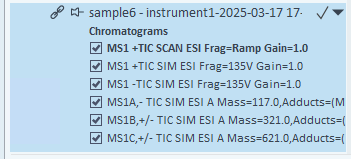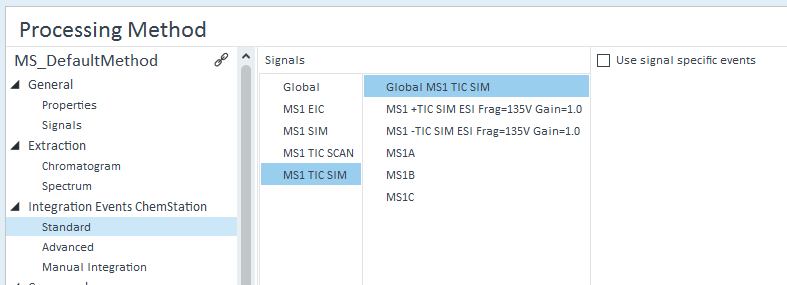Mass-Based Fraction Collection
OpenLab CDS allows to define both UV-based and mass-based triggers for fraction collection.
Results from mass-based fraction collection differ from other results in several aspects:
Target compounds
Fraction results include details on the target compounds.
The Acquisition Setpoints window shows the acquisition method, including target compound definitions.
The Fraction target masses tab in the Injection List window lists all target compounds that you defined in the sequence table. These values override the ones defined in the acquisition method.
The Fraction details sub table in the Fraction Results window lists all target compounds that were detected in the selected fraction.
Chromatograms, Sample container
Fractions collected due to mass-based triggers are shown with a light blue color 
Signals
With Mass-Based Fraction Collection, each target compound is monitored by the MS detector as a single ion. A SIM signal is created for each monitored mass. These signals are named automatically by appending a letter, for example, MS1A, MS1B, MS1C.

To edit signal specific integration events, modify the TIC SIM signal settings in the processing method.

Mass-Based Fraction Collection signals may originate from mixed mass detector settings such as polarity or ionization voltage. Therefore, the signal tools are restricted:
Extracting a chromatogram is available only on the corresponding TIC SIM signal.
Extracting an MS spectrum is available only on the corresponding TIC SIM signal.
Add/Update MS compounds does not evaluate Mass-Based Fraction Collection signals
Qualifiers are not available for compounds defined on a Mass-Based Fraction Collection signal
MS library search is not available for Mass-Based Fraction Collection signals.
MS deconvolution is not available for Mass-Based Fraction Collection signals.
MS sample purity
To calculate MS sample purity on a fraction, reinject the collected fraction.
See Also
Mass-Based Fraction Collection (MBFC)
base-id: 12209641611
id: 9007211464382603